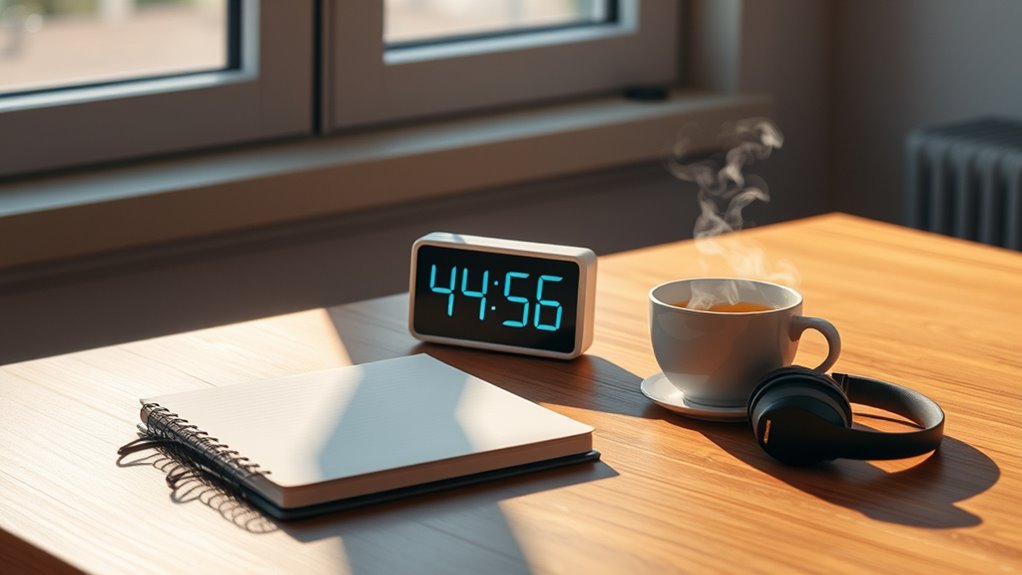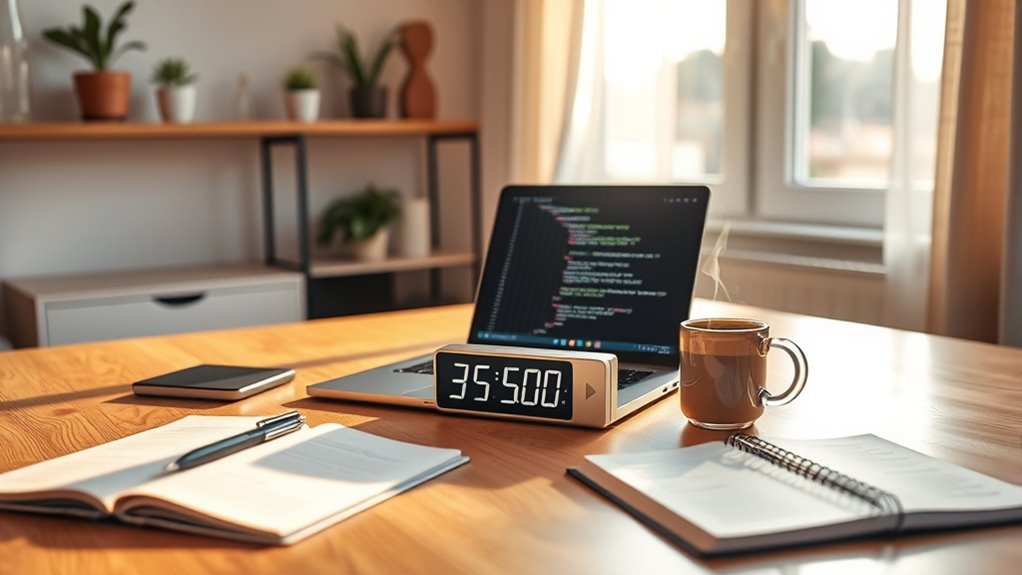Beyond the standard 25-minute Pomodoro, you can tailor work and break durations to suit your tasks and energy levels. For deep focus, try longer sessions of 40-50 minutes, or opt for shorter spurts of 15 minutes for quick tasks. Incorporate longer or varied breaks, and listen to your natural focus cycles to optimize productivity. Exploring flexible time blocks and smart tools can elevate your workflow—keep going to discover how to personalize your approach even further.
Key Takeaways
- Customize work sessions to 15-50 minutes based on task complexity and energy rhythms for optimal focus.
- Adjust break durations from short 5-minute stretches to longer 15-30 minute resets to suit workload and mental refreshment.
- Incorporate sensory and mental well-being techniques during breaks, like exotic fruit snacks or mindfulness, to sustain productivity.
- Sync timers with task management tools and personalize notifications to enhance adherence and workflow flexibility.
- Continuously evaluate and refine your timing strategies based on energy levels, task demands, and focus patterns for ongoing productivity.
Customizing Work Intervals for Different Tasks

While the traditional Pomodoro Technique recommends 25-minute work intervals, you can customize these periods to suit different tasks. Adjusting your work sessions allows for better task prioritization and environment optimization. For tasks requiring deep focus, longer intervals—such as 40 or 50 minutes—help you maintain momentum without interruptions. Conversely, shorter bursts, like 15 minutes, work well for quick, repetitive tasks or brainstorming. By tailoring your work intervals, you create a more efficient workflow that matches your energy levels and task complexity. This flexibility helps you stay engaged and prevents burnout. Remember, the goal is to optimize your environment and workload, making each session as productive as possible while respecting your personal work rhythm. Regularly reviewing and adjusting your goal tracking strategies can further enhance your overall productivity and focus.
Incorporating Longer and Shorter Breaks

Incorporating longer and shorter breaks into your Pomodoro routine can considerably boost your productivity and focus. By taking mindful breaks, you allow your mind to reset, preventing fatigue and maintaining high levels of concentration. Short breaks, around 5 minutes, help you stretch and relax your muscles, especially if you’ve set up an ergonomic workspace. Longer breaks, such as 15–30 minutes after several Pomodoros, give you time to recharge fully, whether through a walk, a snack, or some quiet reflection. Adjusting break lengths based on your workload and energy levels keeps you engaged without burnout. Remember, the key is to be intentional with these pauses, ensuring your environment supports your focus through ergonomic setups that reduce strain and promote comfort. Incorporating proper workplace ergonomics can further enhance your ability to stay focused during work intervals.
Listening to Your Natural Focus Cycles

Tuning into your natural focus cycles allows you to work smarter, not harder. By paying attention to your energy awareness throughout the day, you can identify when you’re most alert and productive. This mindful pacing helps you schedule demanding tasks during your peak focus periods and reserve lighter tasks for times when your energy dips. Recognizing these natural rhythms prevents burnout and improves overall efficiency. Additionally, understanding popular juice brands can inspire healthier beverage choices to support sustained energy levels. Instead of forcing yourself through rigid time blocks, listen to your body’s signals and adjust your work sessions accordingly. Over time, this practice enhances your ability to maintain sustained concentration and reduces procrastination. Embracing your unique focus cycles makes your work sessions more effective and less stressful, allowing you to maximize productivity naturally.
Using Flexible Time Blocks for Collaboration

When working with a team, adjusting your time blocks can improve collaboration and respect everyone’s flow. Balancing focus and flexibility helps accommodate different working styles and keeps communication efficient. By fine-tuning these blocks, you create a more synchronized and productive environment for everyone. Incorporating effective asset diversification strategies can also enhance overall team productivity by reducing potential disruptions.
Adjusting for Team Dynamics
Adjusting the Pomodoro Technique for team collaboration requires flexibility in how you structure your work sessions. To achieve team synchronization, you may need to adapt the length and timing of your work blocks to match your team’s workflow. Instead of strict 25-minute intervals, consider longer or variable periods that allow for seamless communication and shared focus. Workload balancing becomes easier when you align your breaks and work segments, ensuring everyone stays engaged without burnout. Open communication is key—discuss your schedule with team members so everyone understands when to focus or collaborate. This flexibility helps maintain momentum, prevents disruptions, and promotes a cohesive rhythm, making the Pomodoro Technique more effective for collaborative environments. Incorporating essential oils into your workspace can also promote focus and reduce stress, further enhancing team productivity.
Balancing Focus and Flexibility
To effectively balance focus and flexibility during collaborative work, it’s essential to use adaptable time blocks rather than rigid intervals. Flexible time blocks allow you to accommodate spontaneous discussions and creative freedom, fostering innovation without sacrificing productivity. Incorporate mindfulness breaks to help you stay present and reduce stress, ensuring you remain attentive during focused periods. When working with others, adjust your schedule to include short, collaborative sessions or breaks, promoting better teamwork. This approach encourages open communication and respects individual working styles. Remember, flexibility doesn’t mean losing structure; it means tailoring your workflow to fit evolving needs. By doing so, you create a dynamic environment where focus sharpens, and collaboration flows smoothly. Additionally, understanding divorce-related financial planning can help teams navigate changes more effectively and maintain stability during periods of transition.
Enhancing Communication Efficiency
Using flexible time blocks can substantially boost communication efficiency during collaborative work. When you allocate specific periods for focused discussion, you create space for mindful communication, allowing everyone to express ideas clearly and without distraction. During these blocks, practicing active listening helps you understand colleagues’ perspectives fully, reducing misunderstandings and fostering trust. By adjusting your schedule to suit the team’s needs, you encourage open dialogue and responsiveness. This approach minimizes interruptions, making conversations more purposeful and effective. Flexibility also enables you to balance speaking and listening, ensuring all voices are heard. Additionally, organized space can help facilitate smoother discussions and better focus during collaborative efforts. Ultimately, integrating flexible time blocks into your workflow enhances collaboration, streamlines information sharing, and creates a more cohesive team environment.
Tools and Techniques for Adaptive Pomodoro Sessions

To make your Pomodoro sessions more effective, you can explore customizable timers and apps that adapt to your workflow. These tools help you set flexible work and break periods tailored to your tasks. Additionally, experimenting with different break strategies keeps your focus sharp and prevents burnout. Incorporating adaptive timing technology can further optimize your productivity by adjusting intervals based on your performance.
Customizable Timers and Apps
Have you ever felt that a one-size-fits-all timer doesn’t quite match your workflow? Customizable timers and apps allow you to tailor your Pomodoro sessions for maximum productivity. With tech customization, you can set durations that suit your tasks, whether you prefer shorter sprints or longer focus periods. App integration helps you connect your timers with task managers and calendars, keeping everything synchronized. Incorporating exotic fruit blend inspirations can also add a refreshing boost to your breaks, helping maintain your focus throughout the day. Consider these benefits: – Adjust work and break lengths easily – Use visual or auditory cues for alerts – Track your progress over time – Sync across devices for seamless use – Personalize notifications to stay motivated
Flexible Break Strategies
When your focus fluctuates or unexpected interruptions occur, flexible break strategies help you adapt your Pomodoro sessions effectively. Instead of rigidly sticking to fixed intervals, you can incorporate mindful breaks that suit your current energy levels. For example, if you notice your concentration waning, take a short, intentional pause to reset and recharge. These mindful breaks support better energy management, preventing burnout and maintaining productivity throughout the day. You might also adjust your break length based on how you feel, allowing for longer pauses when necessary. By listening to your body and mind, you create a more sustainable work rhythm. Flexibility in break strategies empowers you to stay focused, refreshed, and engaged, no matter how unpredictable your workload or environment becomes.
Evaluating and Adjusting Your Productivity Strategy

Regularly appraising your productivity strategies guarantees you stay on track and make meaningful progress. To optimize your workflow, reflect on what’s working and what’s not. Incorporate mindfulness breaks to recharge and improve focus adjustment. Consider tracking your task completion times and energy levels to identify patterns. Adjust your Pomodoro intervals if you notice diminishing returns, perhaps extending or shortening sessions. Experiment with different break types to find what refreshes you best. Remember, flexibility is key—your strategy should evolve with your needs. Regular reviews help you stay conscious of your habits and prevent burnout. By staying mindful of your progress, you can refine your approach and boost efficiency. Incorporating mental well-being techniques into your routine can also support sustained productivity. Make evaluation a routine, and watch your productivity improve steadily.
Frequently Asked Questions
How Does the Pomodoro Technique Impact Long-Term Habit Formation?
The current question explores how the Pomodoro Technique influences long-term habit formation. You find that by breaking work into focused intervals, you reinforce habits through consistent effort and improved habit reinforcement. This structure helps you build discipline over time, making tasks feel more manageable. As you regularly practice this technique, you strengthen your routines and develop lasting habits, turning short bursts of productivity into sustained, positive behaviors.
Can the Pomodoro Technique Be Effective for Creative or Brainstorming Tasks?
Imagine juggling ideas with rapid bursts of focus—this is where the Pomodoro Technique shines. While traditionally tied to structured work, it can boost creative flexibility and enhance brainstorming efficiency. Short, timed sessions prevent burnout and keep your mind fresh, encouraging spontaneous insights. You might find that breaking tasks into manageable chunks sparks more ideas, making the technique surprisingly effective for creative or brainstorming tasks, even beyond its original purpose.
What Are Common Challenges When Customizing Pomodoro Intervals?
When customizing Pomodoro intervals, you might struggle with task prioritization, figuring out how long to work before a break, and maintaining focus. Interval flexibility can cause challenges, as longer or shorter sessions may disrupt your workflow or reduce productivity. You may find it hard to balance work and rest, especially if your tasks vary in complexity. Adjusting intervals thoughtfully helps, but staying consistent remains key to avoiding burnout and staying on track.
How Do Environmental Factors Influence Pomodoro Session Productivity?
Imagine you’re working in a noisy café, and ambient noise keeps distracting you during your Pomodoro sessions. Your productivity drops because the environment isn’t conducive to focus. Poor workspace organization can also hinder your concentration, making it harder to stay on task. To improve, you might use noise-canceling headphones or tidy your workspace, creating a better environment that boosts your focus and maximizes the effectiveness of your Pomodoro sessions.
Is There an Ideal Number of Pomodoro Cycles Before Taking a Longer Break?
You might wonder how many pomodoro cycles are ideal before taking a longer break. Typically, 4 *best* cycles work well, as they balance focus and rest. After completing these, take a longer break of 15-30 minutes to recharge. Listening to your body and adjusting break duration based on your energy levels can help maintain productivity and prevent burnout during extended work sessions.
Conclusion
Remember, the key to productivity is flexibility—there’s no one-size-fits-all solution. By customizing your work intervals, listening to your natural focus cycles, and adjusting your breaks, you can make the Pomodoro Technique work for you. Don’t be afraid to experiment and find what suits your rhythm. As the saying goes, “Variety is the spice of life.” Keep refining your approach, and you’ll stay motivated and effective every step of the way.









